What was the strongest tournament of all time?
By Jeff Sonas
As with most of the "greatest-ever" debates, there are many ways
to answer this question. The simplest answer is to compare the average FIDE
rating of the participants in each tournament. That is how a tournament's "Category"
is calculated, with 25-point intervals. Thus if the average rating is 2751-2775
it's a "Category 21" tournament; if the average rating is 2726-2750,
it's a "Category 20" tournament, and so on.
The 2009 Tal Memorial in Moscow, recently won by Vladimir Kramnik, was a Category
21 tournament, and I don't believe there has ever been a Category 22 tournament.
Thus by this approach, the 2009 Tal Memorial would be in a tie for the strongest
tournament of all time. However, I do not place much emphasis on "Category"
as a measure of tournament strength, mostly because of the large amount of rating
inflation that has taken place in the past 25 years. Recent tournaments will
look unusually strong by this measure. There must be a more sophisticated way
to measure tournament strength.
There is also the problem that official FIDE ratings have only been around
since about 1970, yet there were important chess tournaments going back more
than a century before then. You can't calculate the strength of a tournament
if there are no ratings available! But fortunately we do have the Chessmetrics
historical ratings that provide month-by-month ratings from January 2005 all
the way back to January of 1843. I haven't calculated new Chessmetrics ratings
since January 2005, so for this current analysis, I just used FIDE ratings for
the period from January 2005 to the present.
Nevertheless, in order to really assess which were the "strongest"
tournaments of all time, you need a method that is completely immune to the
effects of rating inflation. Thus I have decided to avoid using ratings directly,
and instead to use players' world rankings (e.g. #1 in the world, #7 in the
world, etc.) at the time they played in the tournament. This should hopefully
eliminate any problems caused by rating inflation.
Ten years ago I developed a simple trick for calculating
a Category-like number, using just the world rankings (not ratings) of top ten
players in a tournament. I called this alternate number the tournament's "Class",
and it was designed to be in the same magnitude as Category (at least for what
Category meant ten years ago). Here is the calculation:
- A tournament gets 4 points for each participant ranked #1 or #2 in the world.
- A tournament gets 3 points for each participant ranked #3 or #4 in the world.
- A tournament gets 2 points for each participant ranked #5 or #6 in the world.
- A tournament gets 1 point for each participant ranked #7, #8, #9, or #10.
Thus the theoretical maximum, if a tournament included all ten players in the
top-ten, would be a Class of 22. There has never been a Class 22 tournament;
the ten all-time strongest tournaments by this measure have ranged from Class
19 through Class 21:
| |
Tournament |
Class |
Top-10 Participation |
Missing Top-10 Player(s) |
| #1 |
Vienna,
1882 |
21 |
#1, #2, #3, #4, #5, #6, #7, #8, #10 |
#9 S.Rosenthal |
| #2 |
Linares,
1993 |
21 |
#1, #2, #3, #4, #5, #6, #7, #8, #10 |
#9 N.Short |
| #3 |
Nottingham,
1936 |
20 |
#1, #2, #3, #4, #5, #6, #7, #8 |
#9 A.Lilienthal #10 P.Keres |
| #4 |
AVRO,
1938 |
20 |
#1, #2, #3, #4, #5, #6, #7, #8 |
#9 E.Eliskases #10 V.Pirc |
| #5 |
Linares,
1992 |
20 |
#1, #2, #3, #4, #5, #6, #7, #8 |
#9 M.Gurevich #10 A.Shirov |
| #6 |
Wijk
aan Zee 2001 |
20 |
#1, #2, #3, #4, #5, #6, #7, #8 |
#9 E.Bareev #10 B.Gelfand |
| #7 |
London,
1883 |
19 |
#1, #2, #3, #4, #5, #6, #7 |
#8 L.Paulsen #9 V.Hruby #10 A.Wittek |
| #8 |
Wijk
aan Zee 1999
|
19 |
#1, #2, #3, #4, #5, #6, #7 |
#8 M.Adams #9 A.Karpov #10 N.Short |
| #9 |
Linares,
1994 |
19 |
#1, #2, #3, #4, #5, #7, #8, #9 |
#6 V.Salov #10 N.Short |
| #10 |
Hastings,
1895 |
19 |
#1, #2, #3, #4, #6, #7, #8, #9 |
#5 P.Lipke #10 J.Showalter |
As you can see, there have been six tournaments that had the eight top players
in the world, and two of those also had the #10 player (but not the #9 player).
Thus the two highest-Class tournaments of all time were Vienna 1882 and Linares
1993, both Class 21. As a tiebreaker, I would give the nod to Vienna 1882 because
it also included World Champion Wilhelm Steinitz, who was inactive on the rating
list (having not played in six years) and thus not a member of the top ten.
I have previously used the Class calculation to identify the "super-tournaments"
throughout chess history, referring to any tournament having a Class of 15 or
better. There have been 57 such tournaments, including seven during the current
decade (2000 through 2009). The only decade having more super-tournaments was
the previous decade (1990 through 1999), which had thirteen. Here are those
seven tournaments from the current decade (2000 through 2009):
| |
Tournament |
Class |
Top-10 Participation |
| #6 |
Wijk aan Zee, 2001 |
20 |
#1, #2, #3, #4, #5, #6, #7, #8 |
| #25 |
Corus A, 2005 |
17 |
#2, #3, #4, #5, #6, #7, #8, #9 |
| #27 |
Linares, 2000 |
16 |
#1, #2, #3, #4, #5 |
| #29 |
Corus A, 2008 |
16 |
#1, #2, #3, #6, #8, #9, #10 |
| #35 |
Tal Memorial, 2009 |
16 |
#2, #3, #4, #5, #7, #8, #9, #10 |
| #39 |
Linares, 2005 |
15 |
#1, #2, #3, #5, #6 |
| #41 |
Wijk aan Zee, 2000 |
15 |
#1, #2, #3, #5, #7, #9 |
However, this is not the end of the story. The above approach places the most
emphasis on how many top-ten players participated in a tournament, especially
top-six players, but there is no penalty if the tournament includes one or more
lower-rated players. In fact, from that list of the ten tournaments from history
having Class 19+, all but one of them (AVRO 1938) included at least one participant
who wasn't even ranked in the top-50 in the world. This is a real problem with
the above methodology, since I think a lot of people mean "most elite"
when they are talking about the "strongest" tournaments.
So, how can we measure the "most elite" tournament, using only world
rank and not directly using ratings? I would say that however many players a
tournament has, if they are all taken exactly from the top of the rating list,
then it is a perfectly elite tournament. And it should be possible to come up
with a formula to measure how close each tournament came to being perfectly
elite.
Las Palmas 1996 is frequently cited as being the most elite tournament of all
time, supposedly including the top six players and nobody else. However, this
does not appear to be true. From the July 1996 FIDE rating list, we find that
Vassily Ivanchuk (lowest-rated of the six players at Las Palmas) was #7 on the
rating list, with Gata Kamsky (who did not play at Las Palmas) 15 points ahead
of him at #6. Perhaps the "live FIDE ratings" at the time would have
had Ivanchuk higher up and Kamsky down at #7, but of course those are not available
and we wouldn't want to use them even if they were.
Similarly, my Chessmetrics historical ratings for 01-Dec-1996 (right before
the tournament) also have Kamsky at #6 on the list, half a rating point ahead
of #7-ranked Las Palmas participant Veselin Topalov. So it turns out the Las
Palmas 1996 was not perfectly elite. Very very close, but not quite. The only
tournament in history that was perfectly elite was AVRO 1938, which had the
top eight players from the 01-Nov-1938 Chessmetrics rating list, and nobody
else in the tournament.
To continue this analysis, let's look at the recent ten-player Tal Memorial
tournament. An "ideal" ten-player tournament would have players ranked
#1, #2, #3, …, #9, #10. If you add up those ranks, you get 1+2+3+…+9+10=55.
Instead, the Tal Memorial included #12 and #13, and did not include #1 or #6.
So for that tournament, when you add up the ranks, you get 2+3+4+…+10+12+13=73.
Dividing 55 by 73 gives 0.75, and by my simple formula, that tells us the tournament
was "75% of ideal".
We can do this for all the tournaments in history, and unsurprisingly we find
AVRO 1938 on the top of the list, and Las Palmas 1996 at #2 on the list. You
may find a few surprises lower down. And it turns out that the recent Tal Memorial
shows up as the seventh-most-elite tournament of all time, and the most elite
tournament in more than ten years.
| |
Tournament |
%ideal |
players |
"Non-ideal" participant(s) |
"Ideal" player(s) missing |
| #1 |
AVRO,
1938 |
100% |
8 |
(none) |
(none) |
| #2 |
Las
Palmas, 1996 |
95% |
6 |
#7 V.Topalov |
#6 G.Kamsky |
| #3 |
Linares,
1998 |
85% |
7 |
#10 P.Svidler |
#5 A.Karpov |
| #4 |
Zurich
Candidates 1953 |
83% |
15 |
#16 M.Euwe #25 Y.Averbakh |
#2 M.Botvinnik #15 A.Tolush |
| #5 |
Reggio
Emilia, 1991 |
80% |
10 |
#11 A.Beliavsky #12 A.Khalifman #15 L.Polugaevsky |
#6 N.Short #8 E.Bareev #10 A.Jussupow |
| #6 |
St.
Petersburg 1895 |
77% |
4 |
#5 H.Pillsbury |
#2 S.Tarrasch |
| #7 |
Tal Memorial, 2009 |
75% |
10 |
#12 V.Ivanchuk #13 R.Ponomariov |
#1 V.Topalov #6 V.Gashimov |
| #8 |
Linares,
1999 |
75% |
8 |
#17 P.Leko |
#5 A.Shirov |
| #9 |
Dortmund,
2001 |
64% |
6 |
#7 M.Adams #12 V.Topalov |
#1 G.Kasparov #6 V.Ivanchuk |
| #10 |
Budapest
Candidates 1950 |
61% |
10 |
#11 L.Szabo #19 A.Lilienthal #20 S.Flohr |
#1 M.Botvinnik #6 R.Fine #8 S.Reshevsky |
| #11 |
Corus A, 2008 |
60% |
14 |
#15 M.Adams #22 J.Polgar #27 P.Eljanov #36 L.van Wely |
#4 A.Morozevich #5 P.Svidler #7 A.Shirov #14 S.Karjakin |
| #12 |
Bilbao, 2008 |
60% |
6 |
#7 T.Radjabov #12 L.Aronian |
#2 V.Kramnik #3 A.Morozevich |
This is certainly an interesting list, and indicates the historical significance
of the 2009 Tal Memorial. You will notice that out of all events that lacked
the top-ranked player in the world, it qualifies as the most "elite"
tournament ever, since it brought together 10 of the next 12 players below #1
Veselin Topalov, with no participants worse than #13 in the world.
Normally you might think it would be one of the first five FIDE World Championship
Candidates Final tournaments (1950 through 1962) that would qualify for the
odd distinction as the "most-elite" tournament that also lacked the
top-ranked player in the world. In fact, while the 1950 Budapest tournament
did indeed attempt to bring together the next ten players after top-rated Mikhail
Botvinnik, you can see from the above table that more top-ten-players were omitted
than in the recent Tal Memorial, and Budapest also included two participants
well below #13 in the world, so on both counts the Tal Memorial seems to have
been more elite. And my historical ratings did not consider World Champion Botvinnik
to be the top-rated player in the world at the time of the 1953, 1956, 1959,
or 1962 Candidates Finals, so in fact each of those tournament did include the
top-ranked player in the world (S.Reshevsky in 1953, V.Smyslov in 1956, M.Tal
in 1959, and T.Petrosian in 1962) according to Chessmetrics.
In any event, one could legitimately argue that it is a serious omission for
an "elite" tournament to be lacking the very top player in the world.
It is true that my simple formula would penalize a tournament as much for including
the #19 player instead of the #9 player, as it would for including the #11 player
instead of the #1 player, and that probably isn't quite right. Instead of a
pattern like 1+2+3+…+9+10, we could use the reciprocal of the world rank,
and thus it would be 1.00+0.50+0.33+0.25…+0.11+0.10 instead. This rewards
the events more that have full participation from the top handful from the rating
list, and at the other end it doesn't care as much whether you have #20 or #30.
This modification brings Las Palmas 1996 even closer to the "ideal"
AVRO 1938. By this final measure, here are the 12 most "elite" tournaments
of all time:
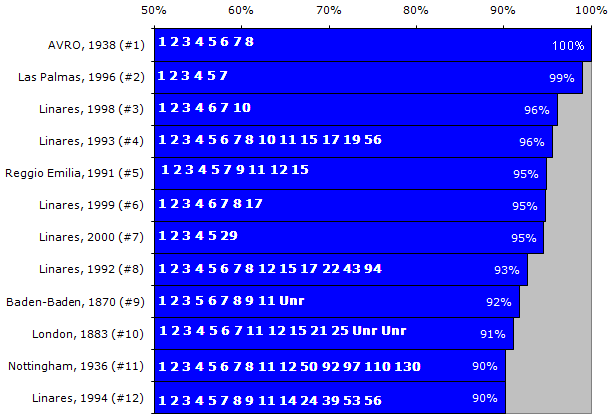
Clearly it would be very hard to argue with the choice of AVRO, 1938 as the
strongest, most elite tournament of all time, the perfect blend of top-ten participation
and elite selectivity. After that tournament, it's not as clear; it really depends
on whether you think a "strong" tournament means it has a host of
top-ten players, or if you mean it is an extremely elite event. It is difficult
for one tournament to accomplish provide both. Either way, the above data should
hopefully be a good resource for the next time you want to argue about what
was the strongest tournament of all time!
Copyright
Chessmetrics
Cross tables of the twelve top tournaments
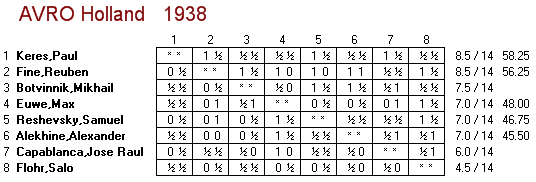


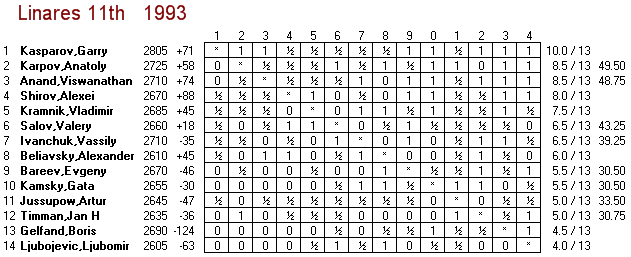
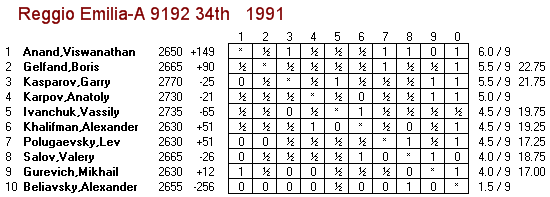


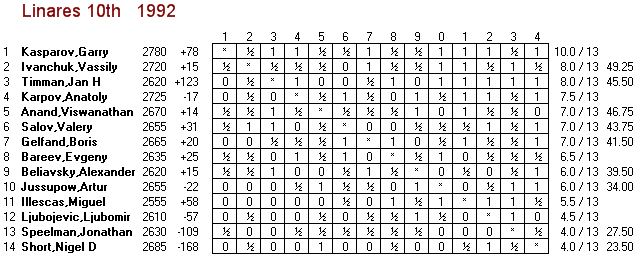

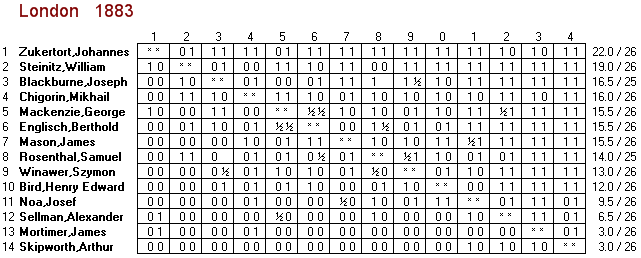
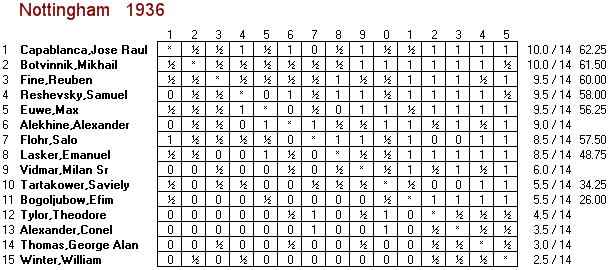
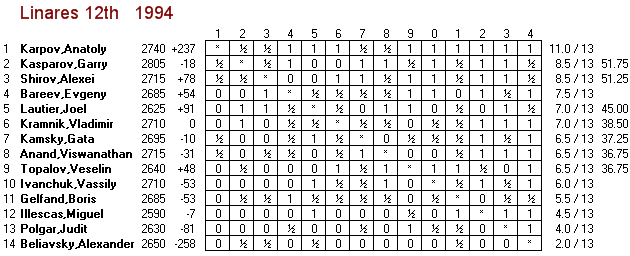
Looking back in nostalgia
In 1996, with the Las Palmas tournament completed, the fledgling ChessBase
news page, set up with the assistance of John Nunn, was up and running. The
Wayback Machine has archived
the front page from December 18 (but not all the links), and this is what it
looked like:

As you can see we had a report on the second strongest tournament of all time,
with blinking headline and all. Unfortunately the report itself is gone, although
you can still see it, with pictures and videos, on an ancient CD of ChessBase
Magazine. Click around the above
page for other fun bits – and no, we are not taking orders for Fritz
4 or ChessBase 6 any more.





































